Food for the Soul: da Vinci, Paris – Part 3
A good painter has two things to represent: the man and the intention of his soul. The former is easy, the latter hard.” — Leonardo da Vinci
By Nina Heyn- Your Culture Scout
It is amazing that 500 years on, we still see news stories about da Vinci in daily press. There was one recently in BBC news about a purported second Mona Lisa that being held in a Swiss bank vault. A week before, the was another news story about the mysterious disappearance from view of Salvator Mundi – the Christ portrait that sold as a da Vinci masterpiece at Christie’s in late 2017, then it was scheduled for unveiling at the Louvre Abu Dhabi, failed to show up, and now it has also failed to make an appearance at the long-awaited major exhibition that has been mounted by The Louvre Museum in Paris. It’s not the Louvre’s fault – the painting has purportedly been acquired by the current ruler of Saudi Arabia, and it is now probably ensconced at a Swiss vault (the painting, not the ruler). To provide at least an insight into this image, the museum brought over a beautiful copy of Salvator Mundi (so called version Ganay), painted by Leonardo’s pupil in early 1500’s, most likely with the master’s guidance.
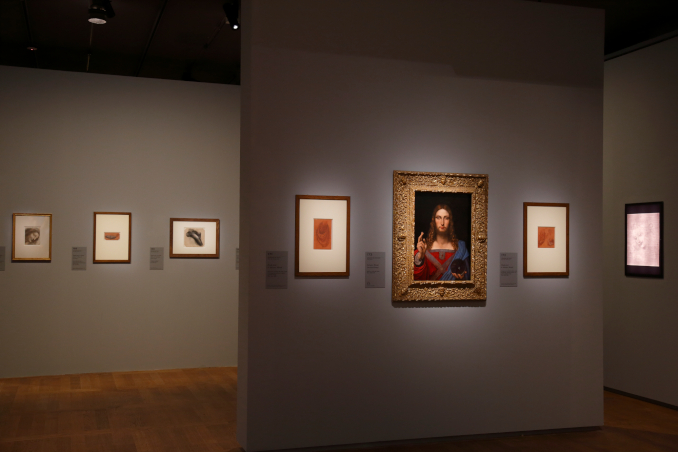
Workshop of Leonardo da Vinci. Salvator Mundi version Ganay. 1505-1515. Private collection. Photo Credit: Antoine Mongodin for the Louvre exhibition “Leonardo da Vinci”
There is plenty of authentic treasures that the museum has gathered for a historic exhibition on the 500th anniversary of Da Vinci’s passing. As far as da Vinci’s art goes, the Louvre is already the powerhouse since it owns five of his pictures – a one third of all his confirmed paintings. The exhibition, entitled simply “Leonardo da Vinci,” has been ten years in planning, including five years of negotiations with a dozen world museums to loan their most prized possessions.
The exhibition has been designed around milestones in da Vinci’s artistic development. The “Light, shade and relief” presents the influences of da Vinci’s teacher Verrocchio on the young artist who learned complex shading of cloth and twists of human body from the sculptures he studied. Another section, entitled “Life,” concentrates on da Vinci’s transition from earlier techniques to his famous sfumato (blurring of the edges for seamless transitions) that reflected his studies of light, motion and optics. His most accomplished works of St. John the Baptist, Last Supper, St Anne, Battle of Anghiari and his crowning sfumato achievement of Mona Lisa all come from this period.
When da Vinci was left without a patron after Lorenzo Sforza, the Duke of Milan, lost his power and then life, the artist spent a few years wandering around Italian principalities. Only in the last few years of life he found a safe harbor at the court of a newly installed, young French king Francois 1st. In 1516 he offered da Vinci a manor next to the royal castle of Amboise and provided him with a regular stipend that freed the master from taking on painting commissions, or interrupting his studies to design a military project. All the king has really sought was a chance to be in the presence of the greatest minds of that time. It is not surprising that the kings’ esteem continued after da Vinci’s death – he purchased the Mona Lisa for his collection.
This portrait remains a jewel in the crown of the Louvre’s collection, and the current exhibition offers a very modern way to understand this painting. Adjacent to the exhibition halls there is Louvre’s first foray into Virtual Reality through a show “Mona Lisa: Beyond the Glass”- an immersive experience where you can view details of the actual painting (the cracked wood panel, the sfumato technique of painting), and then “see” the “live Gioconda” as she is seated at a Tuscan villa with Leonardo’s landscape around her. You can examine her gestures, her hairdo, and even experience a flight in one of his flying machines. For an artist who had a lifelong fascination with technology, this is a fitting idea – using the VR techniques to put his model, his landscape and his flying machines in motion.

Leonardo da Vinci. The Virgin and Child with Saint Anne. © RMN-Grand Palais Musée du Louvre. Photo credit: René-Gabriel Ojéda. Courtesy of the Louvre exhibition “Leonardo da Vinci.”
The exhibition showcases all other four paintings at the Louvre: a charming portrait of Lucrezia Crivelli which is traditionally if erroneously called La Belle Ferronière, the first version of the Virgin of the Rocks (the other one is at the National Gallery in London), The Virgin and Child with St Anne which is considered the most complex of surviving da Vinci’s paintings, and the famous pointing upwards image of Saint John the Baptist. Seeing all these masterpieces in one space is already a visual feast but it is a number of visiting treasures that make this a lifetime opportunity to be in the presence of da Vinci’s art.
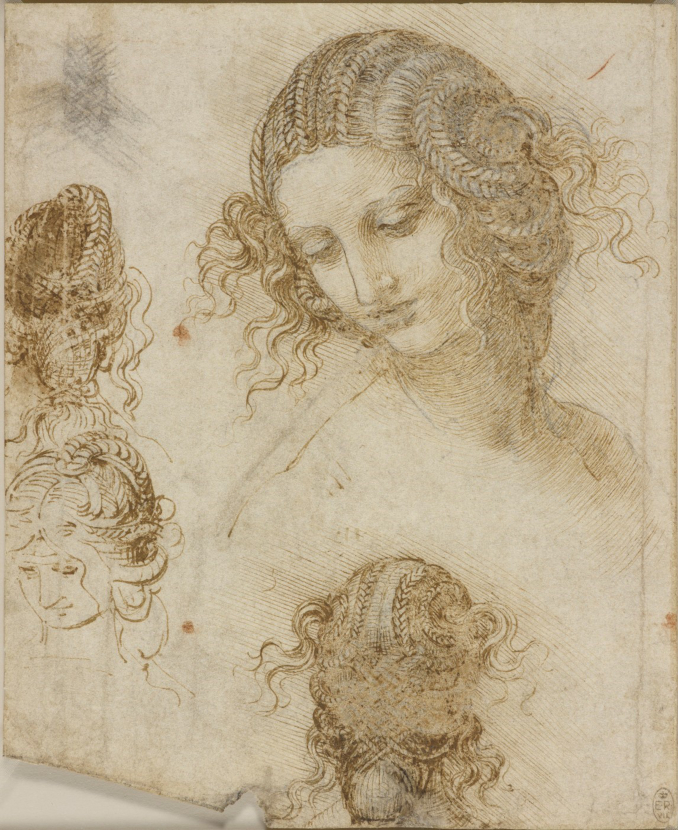
Leonardo da Vinci. Study of the head of Leda. 1505-1506.- Windsor Castle. The Royal Collection, Royal Library 12516. Royal Collection Trust/© Her Majesty Queen Elizabeth II 2019. Photo credit: Courtesy of the Louvre exhibition “Leonardo da Vinci.”
From London, there is so called Burlington House Cartoon– a famous preparatory drawing for The Virgin and Child with Saint Anne. It is one of the many studies the artist made to figure out the composition, gestures, and folds of fabric for this complex painting. From the Queen Elizabeth II’s collection at Windsor Castle there are many wonderful drawings of the head of Leda, as well as studies of rock stratifications, flowers and anatomical sketches. The Vatican gallery has yielded an unfinished but so powerful oil sketch of Saint Jerome in the Wilderness – an incredible anatomical study and a psychological portrait of religious fervor. And had the artist finished to paint a ferocious lion at the saint’s feet, it would have been probably as magnificent as those painted by Rubens a couple of centuries later.
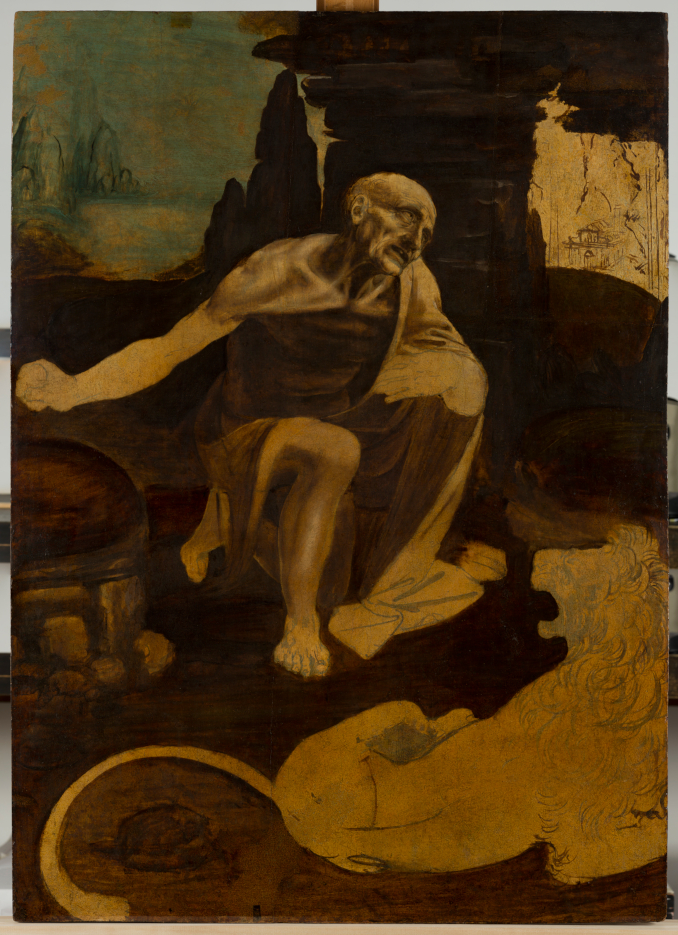
Leonardo da Vinci. Saint Jerome in the Wilderness. Photo © Governatorate of the Vatican City State – Vatican Museums. All rights reserved. Photo credit: Courtesy of the Louvre exhibition “Leonardo da Vinci.”
Some of the paintings were too precious or too fragile to travel – such as Lady with an Ermine (in Krakow, Poland), Madonna of the Carnation (in Munich, Germany) or Virgin of the Rocks (London version) and these have not made it to the exhibition. However, Louvre made up for these absences by showcasing many rare and exquisite pages from the master’s notebooks, including the famous Vitruvian Man – da Vinci’s most iconic image used in countless ways for centuries. This drawing, normally kept in Venice’s Gallerie Dell’Accademia, here can be compared with many other engineering, medical and scientific drawings created by da Vinci over decades of his life.
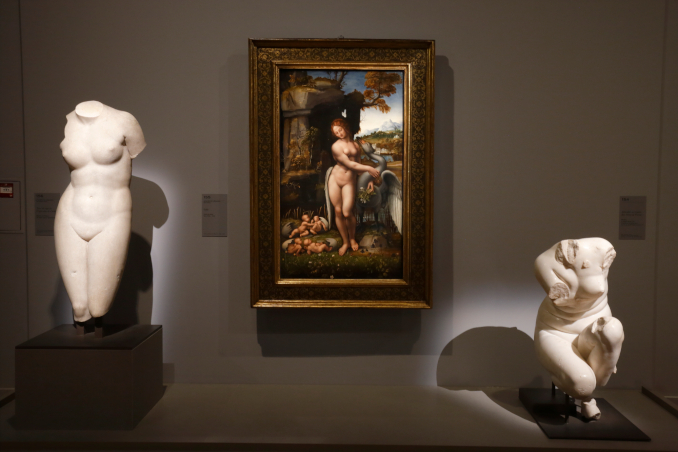
In the back: Atelier de Leonardo da Vinci. Leda. 1505-1510. Florence L’Uffizi Gallery. In the front: copies of Praxiteles torsos of Aphrodite from The Louvre collection of Greek antiquities. Photo Credit: Antoine Mongodin for the Louvre exhibition “Leonardo da Vinci”
Since the original Last Supper has been losing its pigments within a dozen years of its creation (and the subsequent cutting out of a portion of the wall by Benedictine monks, water and age damage, and a WWII bombing did not help), the original fresco at the refectory hall of Santa Maria delle Grazie in Milan is much faded. The Louvre brought out from its collection an oil copy that was painted in presence of the fresh original in 1509 by da Vinci’s pupil Marco D’Oggiono. This painting is normally housed in the National Museum of Renaissance at Ecouen. While it is not by the master’s hand, it is a perfect way to see what he intended in terms of colors and details that have long been lost since. In a similar way we can get an insight into da Vinci’s Leda. Since the original painting is now lost, the exhibition displays a loan from the Uffizi Gallery in Florence: a great copy that was painted in early 16th century by one of the artist’s apprentices.
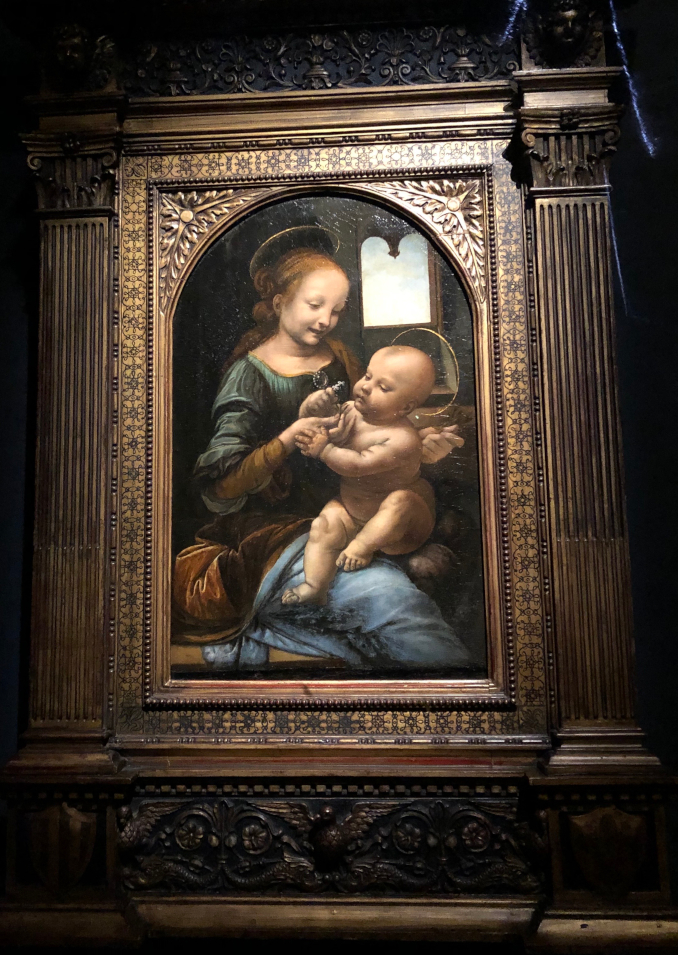
Leonardo da Vinci. Virgin and Child, so called Benois Madonna. 1480-1482. The State Hermitage Museum, St. Petersburg.Image from the Louvre exhibition “Leonardo da Vinci.”
Last but not least, a special mention should be awarded to the presence of so called Benois Madonna– a smallish painting in an ornate frame of Virgin and Child. This devotional painting from about 1480 normally resides at the State Hermitage Museum in St. Petersburg. It’s one of the artist’s most beautiful Madonnas, and it is a major feat for the Louvre to have loaned it.
The Louvre’s “Leonardo da Vinci” exhibition displays altogether 160 works by da Vinci, his pupils, copyists and various contemporaries. The exhibition is open at the Louvre between October 24, 2019 – February 24, 2020.
Check It Out!
Related Reading:
Food for the Soul: Da Vinci and Salt
Food for the Soul: Sky Ladder, da Vinci, and Collecting Modern Art
Food for the Soul: The Year of da Vinci
Food for the Soul: Da Vinci Part 2 – Milan
Food for the Soul: The Year of da Vinci – Interview with a Milanese – Journalist Paola Jacobbi
